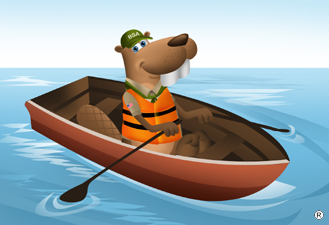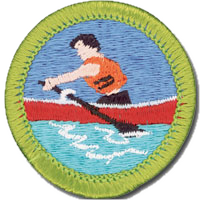Rowing


Resources
- Rowing Merit Badge Pamphlet
- Rowing Merit Badge Class Preparation Page
- Rowing Merit Badge Workbook
- Scoutmaster Bucky's Merit Badge Advancement Quick Reference
- Scoutmaster Bucky's Acknowledgement Form
Rowing Requirements
Current Scouts BSA requirements
as of December 6, 2025
as of December 6, 2025
1.
Do the following:
a.
Explain to your counselor the most likely hazards you may encounter
while participating in rowing activities, including weather- and
water-related hazards, and what you should do to anticipate, help
prevent, mitigate, and respond to these hazards.
b.
Review prevention, symptoms, and first-aid treatment for the following
injuries or illnesses that can occur while rowing: blisters,
hypothermia, heat-related illnesses, dehydration, sunburn, sprains, and
strains.
c.
Review the Scouting America Safety Afloat policy. Explain to your
counselor how this applies to rowing activities.
2.
Before completing requirements 4, 5, 6, and 7, successfully complete the
Scouting America swimmer test.
3.
Review the characteristics of life jackets most appropriate for rowing and
why one must always be worn while rowing. Then demonstrate how to select
and fit a life jacket.
4.
Do ONE of the following:
a.
Alone or with a passenger, do the following in either a fixed-seat or
sliding-seat rowboat:
1.
Launch.
2.
Row in a straight line for 100 yards. Stop, pivot, and return to
the starting point.
3.
Backwater in a straight line for 25 yards. Make a turn underway and
return to the starting point.
4.
Land and moor or rack your craft.
5.
Tie the following mooring knots—clove hitch, roundturn with two
half-hitches, bowline, Wellman's knot, and mooring hitch.
b.
Participate as a rowing team member in a competitive rowing meet. The
team may be sponsored by a school, club, or Scout unit. The meet must
include competition between two or more teams with different sponsors.
Complete at least 10 hours of team practice prior to the meet.
5.
Do ONE of the following:
a.
In a fixed-seat rowboat, come alongside a pier and help a passenger
into the boat. Pull away from the pier, change positions with your
passenger, and demonstrate sculling over the stern or side. Resume your
rowing position, return alongside the pier, and help your passenger out
of the boat.
b.
In a sliding-seat rowboat, come alongside a pier and, with your buddy
assisting you, get out onto the pier. Help your buddy into the boat.
Reverse roles with your buddy and repeat the procedure.
6.
Participate in a swamped boat drill including righting and stabilizing the
craft, reboarding in deep water, and making headway. Tell why you should
stay with a swamped boat.
7.
Alone in a rowboat, push off from the shore or a pier. Row 20 yards to a
swimmer. While giving instructions to the swimmer, pivot the boat so that
the swimmer can hold on to the stern. Tow the swimmer to shore.
8.
Describe the following:
a.
Types of craft used in commercial, competitive, and recreational
rowing
b.
Four common boatbuilding materials. Give some positive and negative
points of each
c.
Types of oarlocks used in competitive and recreational rowing.
9.
Discuss the following:
a.
The advantage of feathering oars while rowing
b.
Precautions regarding strong winds and heavy waves, and boat-handling
procedures in rough water and windstorms
c.
How to properly fit out and maintain a boat in season, and how to
prepare and store a boat for winter
d.
How to determine the proper length of oars
e.
The differences between fixed-seat and sliding-seat rowing
f.
The different meanings of the term sculling in fixed- and
sliding-seat rowing
g.
The health benefits from rowing for exercise